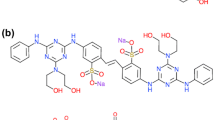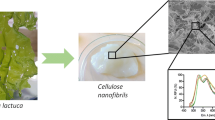Summary
The effects of 2,6-dichlorobenzonitrile (DCB, a known inhibitor of cellulose synthesis) and Tinopal LPW (TPL, an agent which disrupts glucan crystallization) on the structure of cellulose synthesizing complexes (terminal complexes, TCs) in the xanthophycean algaVaucheria hamata were investigated. DCB (10 μM) inhibits nascent fibril formation from the TC subunit (based on the absence of impressions) although it does not alter the overall shape of the rectangular TC during the short treatment of 20 min. With a prolonged treatment (60 min), the arrangement of TC subunits becomes disordered, and particles generally exhibited as doublets of subunits are released from each other. DCB also interferes with the formation of the overall shape of the TC although it does not disturb the conversion into TC rows of the subunits (the zymogenic precursor of the TC) packed in the globules. A 15 min treatment with TPL (1 mM) destroys the TC integrity by reducing the subunits into small fragments or particulate aggregates. The particulate rows of the TC are interrupted at many points, and fragments and particulate aggregates are dispersed by prolonged treatment (45 min) with TPL. Unlike DCB, TPL inhibits the conversion of globule subunits into TC rows. New insights on the structural characteristics necessary for cellulose microfibril assembly and possible mechanisms for the biogenesis of theVaucheria TC come from these data.
Similar content being viewed by others
Abbreviations
- DCB:
-
2,6-dichlorobenzonitrile
- TPL:
-
Tinopal LPW
- TC:
-
terminal complex
References
Benziman M, Haigler CH, Brown RM Jr, White AR, Cooper KM (1980) Cellulose biogenesis: polymerization and crystallization are coupled processes inAcetobacter xylinum. Proc Natl Acad Sci USA 77: 6678–6682
Brown RM Jr, Montezinos D (1976) Cellulose microfibrils: visualization of biosynthetic and orienting complexes in association with the plasma membrane. Proc Natl Acad Sci USA 73: 143–147
—, Haigler CH, Cooper K (1982) Experimental induction of altered nonmicrofibrillar cellulose. Science 218: 1141–1142
Buron MJ, Garcia-Herdugo G (1983) Experimental analysis of cytokinesis: comparison of inhibition induced by 2,6-dichlorobenzonitrile and caffeine. Protoplasma 118: 192–198
Delmer DP (1987) Cellulose biogenesis. Annu Rev Plant Physiol 38: 259–290
Haigler CH, Brown RM Jr, Benziman M (1980) Calcofluor White ST alter the in vitro assembly of cellulose microfibrils. Science 210: 903–906
Herth W (1987) Effects of 2,6-DCB on plasma membrane rosettes of wheat root cells. Naturwissenschaften 74: 556–557
Itoh T, O'Neil RM, Brown RM Jr (1984) Interference of cell wall regeneration ofBoergesenia forbesii protoplasts by Tinopal LPW, a fluorescent brightening agent. Protoplasma 123: 174–183
Mayer Y, Herth W (1978) Chemical inhibition of cell wall formation and cytokinesis, but not of nuclear division, in protoplasts ofNicotiana tabacum L. cultured in vitro. Planta 142: 253–262
Mizuta S (1985 a) Assembly of cellulose synthesizing complexes on the plasma membrane ofBoodlea coacta. Plant Cell Physiol 26: 1443–1453
— (1985 b) Evidence for the regulation of the shift in cellulose microfibril orientation in freeze-fractured plasma membrane ofBoergesenia forbesii. Plant Cell Physiol 26: 53–62
—, Brown RM Jr (1992) High resolution analysis of the formation of cellulose synthesizing complexes inVaucheria hamata. Protoplasma 166: 187–199
—, Okuda K (1987) A comparative study of cellulose synthesizing complexes in certain siphonocladalean and cladophoralean algae. Bot Mar 30: 205–215
—, Roberts EM, Brown RM Jr (1989) A new cellulose synthesizing complex inVaucheria hamata and its relation to microfibril assembly. In: Schuerch C (ed) Cellulose and wood-chemistry and technology. Wiley, New York, pp 659–676
Montezinos D, Delmer DP (1980) Characterization of inhibitors of cellulose synthesis in cotton fibers. Planta 148: 305–311
Quader H, Robinson DG, Kempen R (1983) Cell wall development inOocystis solitaria in the presence of polysaccharide binding dyes. Planta 157: 317–323
Roberts EM, Seagull RW, Haigler CH, Brown RM Jr (1982) Alteration of cellulose microfibril formation in eukaryotic cells: Calcofluor White interferes with microfibril assembly and orientation inOocystis apiculata. Protoplasma 113: 1–9
Robinson DG, Quader H (1981) Structure, synthesis and orientation of microfibrils. IX. A freeze-fracture investigation of theOocystis plasma membrane after inhibitor treatments. Eur J Cell Biol 25: 278–288
Rudolph U, Gross H, Schnepf E (1989) Investigations of the turnover of the putative cellulose-synthesizing particle “rosettes” within the plasma membrane ofFunaria hygrometrica protonema cells II. Protoplasma 148: 57–69
Venverloo CJ, Goosen-de Roo L, Van Sponsen PC (1984) Cell division inNautilocalyx explants. III. Effects of 2,6-dichlorobenzonitrile on phragmosome, band of microtubules and cytokinesis. J Plant Physiol 166: 225–234
Author information
Authors and Affiliations
Rights and permissions
About this article
Cite this article
Mizuta, S., Brown, R.M. Effects of 2,6-dichlorobenzonitrile and Tinopal LPW on the structure of the cellulose synthesizing complexes ofVaucheria hamata . Protoplasma 166, 200–207 (1992). https://doi.org/10.1007/BF01322782
Received:
Accepted:
Issue Date:
DOI: https://doi.org/10.1007/BF01322782




